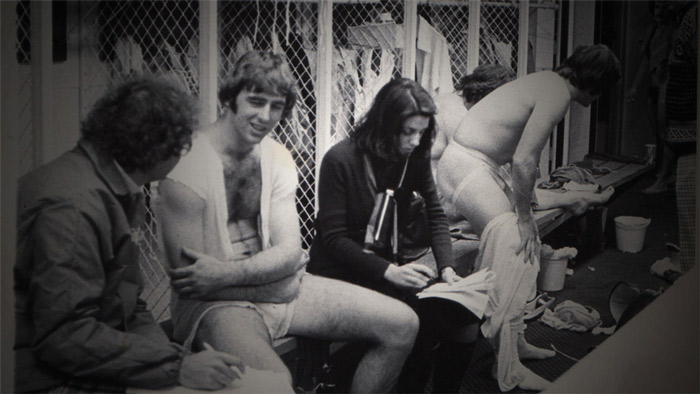Misogyny is alive and thriving in the boys clubs of sports and sports journalism. Three female reporters were temporarily barred from entering the Jacksonville Jaguars’ locker room after the team’s loss to the Indianapolis Colts by an usher who, according to Graham Watson of Yahoo Sports, was unsure whether women were allowed in the room because, “you know how guys are.” The media relations teams for both the Jaguars and the Colts swiftly apologized to the women, but the incident is an unsettling reflection of today’s sports media landscape.
I was just blocked from a locker room by an old, out-of-touch geezer who wasn't sure women were allowed because "you know how guys are."
— Graham Watson (@Yahoo_Graham) October 4, 2015
There’s a pervasive myth that sexism in sports journalism doesn’t exist to a serious extent, despite the fact that angry men on Twitter have made it perfectly clear that they think women don’t belong in the sports world. Even when female journalists are not being sent rape threats and called vile names over disagreements about the predictive stats of a minor player, they’re often being objectified—particularly if the women in question are television personalities. The top Google result for “female sports journalists” is an article from Men’s Fitness titled 40 hottest female sports reporters. The introduction to the piece proudly includes the disclaimer: “Some of the most attractive and charming women in the country are filling up the sidelines with awesome commentary and interviews—though we are often too distracted to notice.”
Beyond these blatant objectifications and threats of physical violence are the multiple incidents of sexual harassment that female reporters face daily. There are multiple cringe-worthy videos depicting Erin Andrews, a FOX Sports broadcaster, being harassed by interview subjects, from 50 Cent attempting to kiss her on air to a college football player grinding on her in the middle of a sideline report. In a piece published on Sports Illustrated, multiple female reporters who chose to remain anonymous recounted incidents where they were invited to players’ hotel rooms, denied interviews because they had rejected players’ advances, or were sent seuxally explicit messages from coaches.
This is happening in spite of the fact that multiple universities across Canada are fighting to hire female varsity coaches, and that high-level female athletes, such as unstoppable UFC Champion Ronda Rousey and 21-time Grand Slam Winner Serena Williams, are receiving increasingly positive coverage. It seems that though barriers are being torn down for women in professional sports, female reporters still face an uphill climb.
This situation is exacerbated by a prevailing argument that women simply aren’t interested in becoming sports journalists, hence the dearth of female reporters. That type of logic is a self-fulfilling prophecy, as potential female role models in the field of sports journalism are often pushed to the sidelines, both literally and metaphorically. Women are then delegated to sideline reporting, where they are generally limited to just a few minutes of screen-time asking basic questions of the players, not delivering critical analysis. There are only a handful of women who serve as anchors on TSN and ESPN, and those who do in-game analysis are subjected to mindless criticism. This is a sorry state of affairs considering that female reporters had to fight numerous legal battles to get the same access to the players as their male counterparts—Melissa Ludtke won the right for female journalists to enter the locker room in 1978. Though sideline reporting is important, it is far less inspiring for young girls who have an interest in journalism.
Often, the reason there isn’t talk of the consistent harassment and irritation faced by female sports journalists is because the women are simply tired of talking about it. Women who are vocal about their experiences in the boys club may receive messages claiming they just aren’t cut out for this field. And women will have to contend with working in male-dominated newsrooms geared towards pleasing a male readership.
It’s unfortunate that after years of fighting for equal access and opportunity for female reporters, three more were barred from a locker room. Unfortunately, these women will join the ranks of many others who deal with daily discrimination on the job; but it’s necessary that their story be heard. Hopefully, this incident will inspire more female professionals to speak out against direct misogyny and ultimately smash through the glass ceiling that has kept them down for so long.









